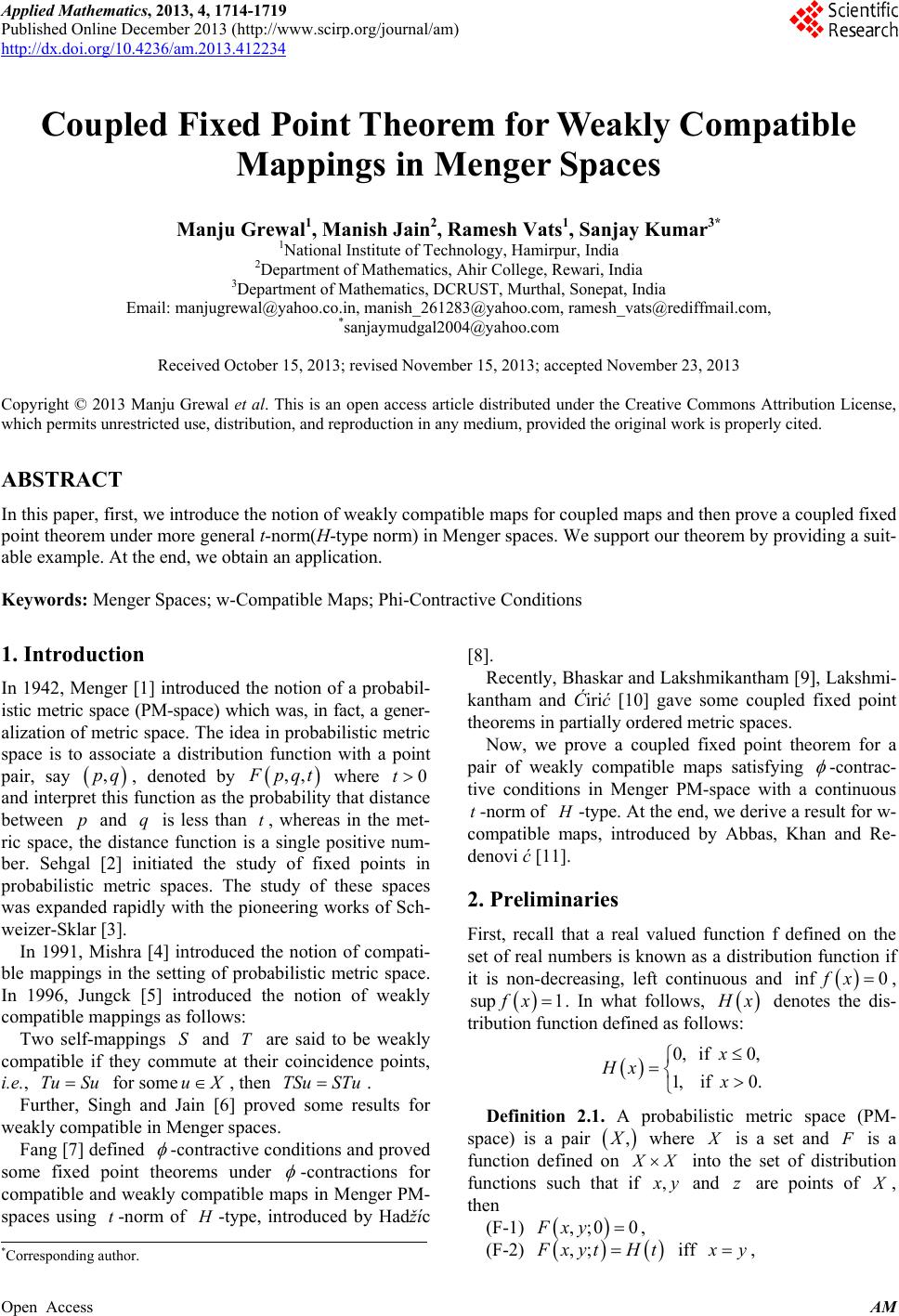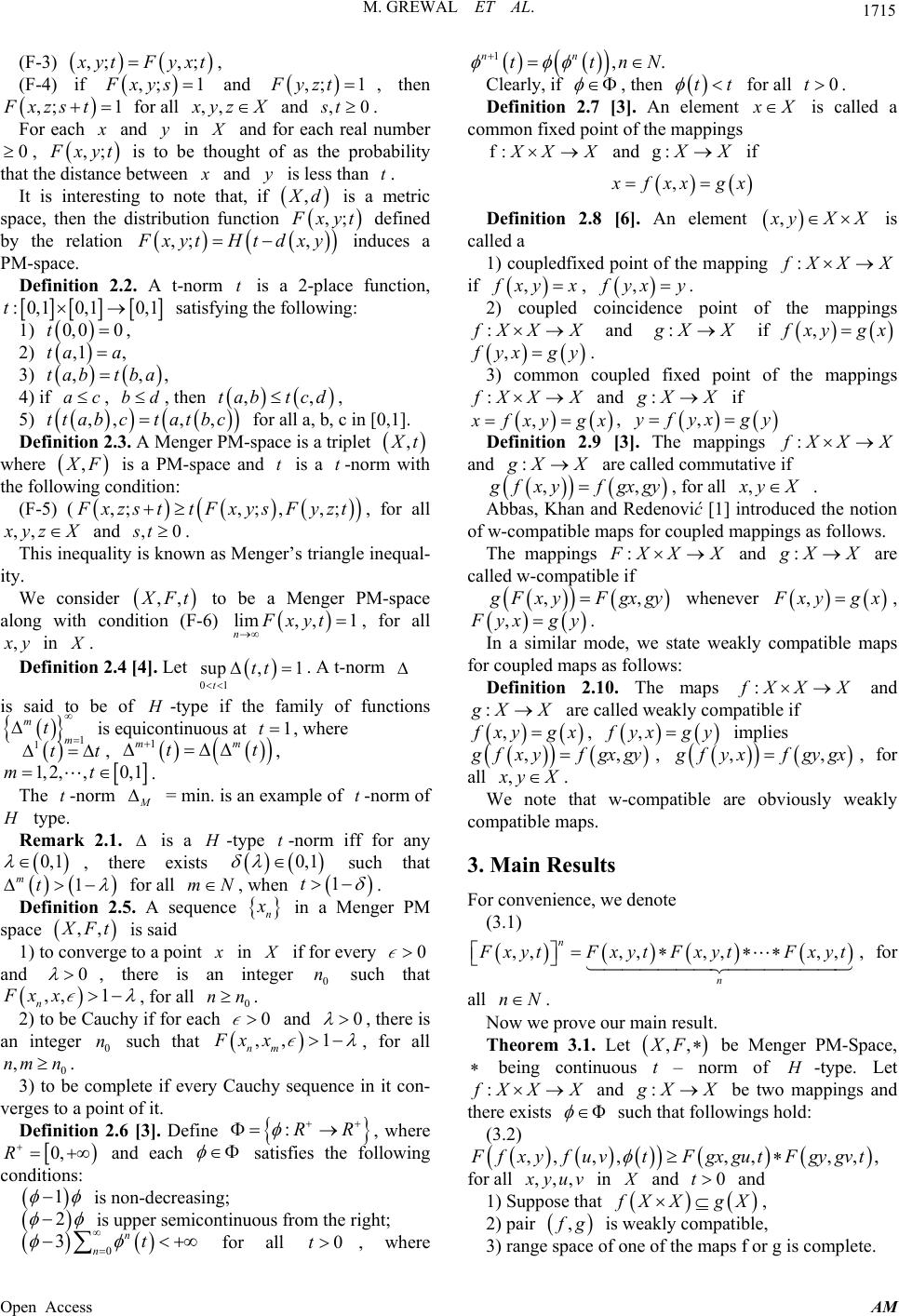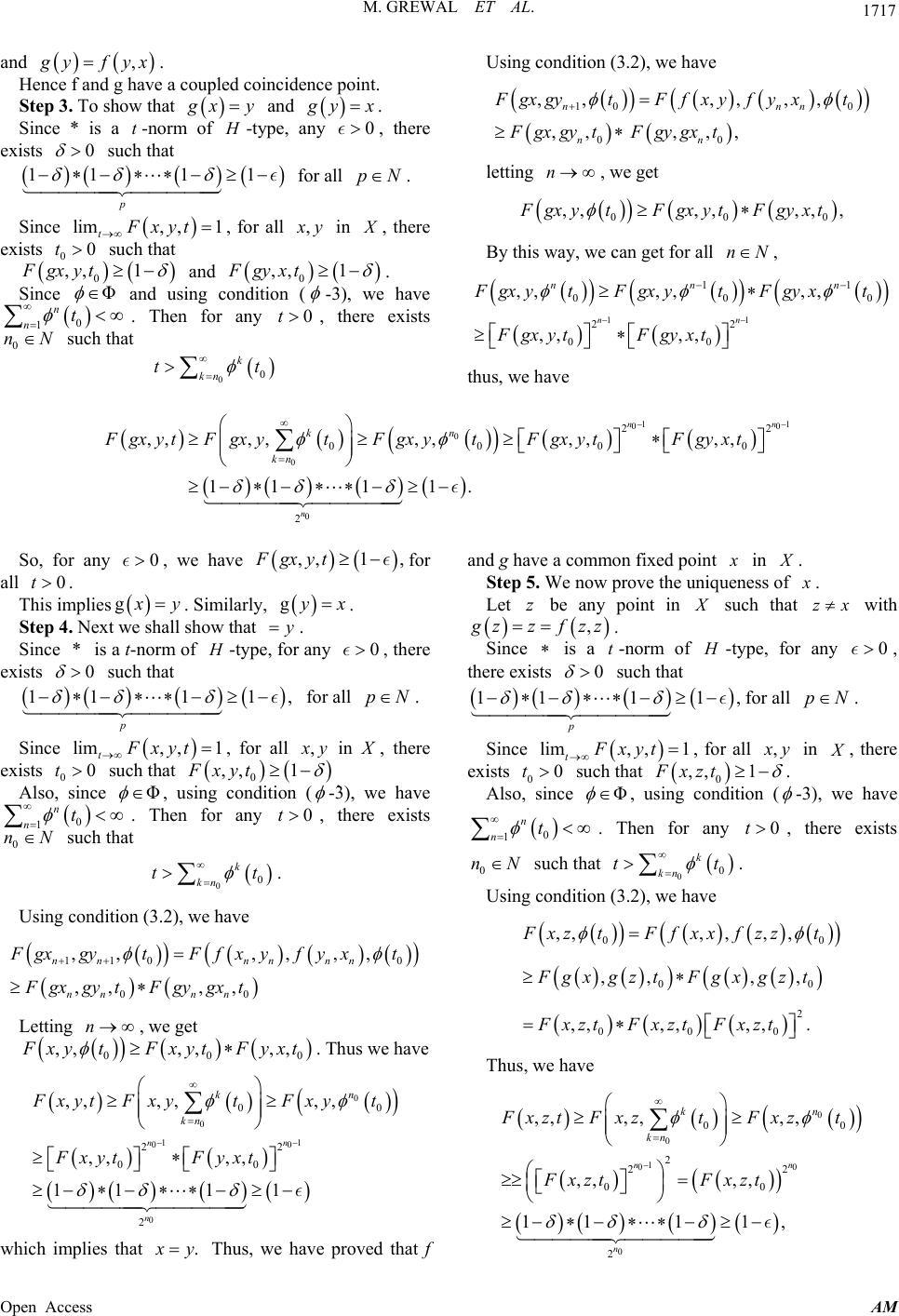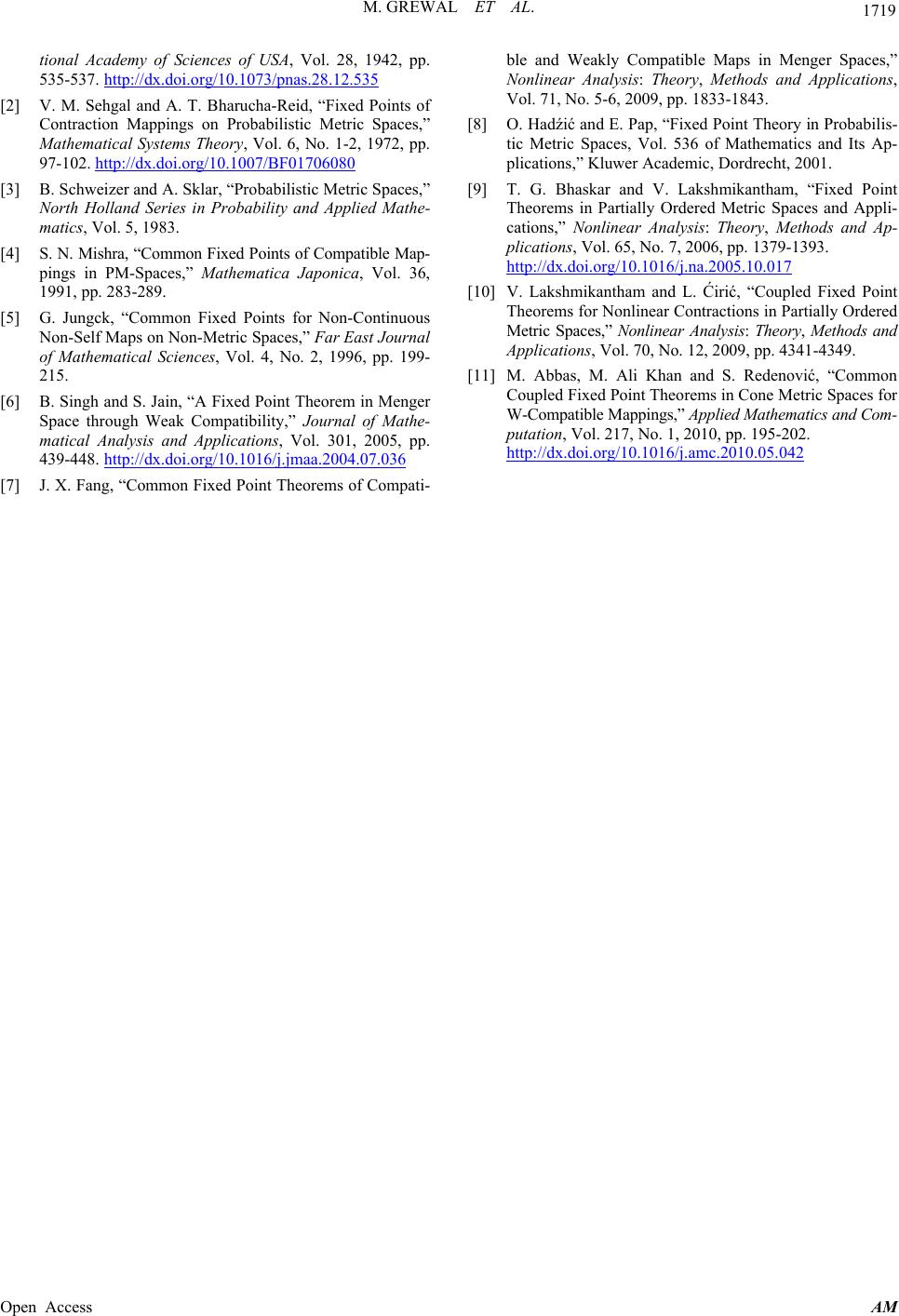 Applied Mathematics, 2013, 4, 1714-1719 Published Online December 2013 (http://www.scirp.org/journal/am) http://dx.doi.org/10.4236/am.2013.412234 Open Access AM Coupled Fixed Point Theorem for Weakly Compatible Mappings in Menger Spaces Manju Grewal1, Manish Jain2, Ramesh Vats1, Sanjay Kumar3* 1National Institute of Technology, Hamirpur, India 2Department of Mathematics, Ahir College, Rewari, India 3Department of Mathematics, DCRUST, Murthal, Sonepat, India Email: manjugrewal@yahoo.co.in, manish_261283@yahoo.com, ramesh_vats@rediffmail.com, *sanjaymudgal2004@yahoo.com Received October 15, 2013; revised November 15, 2013; accepted November 23, 2013 Copyright © 2013 Manju Grewal et al. This is an open access article distributed under the Creative Commons Attribution License, which permits unrestricted use, distribution, and reproduction in any medium, provided the original work is properly cited. ABSTRACT In this paper, first, we introduce the notion of weakly compatible maps for coupled maps and then prove a coupled fixed point theorem under more general t-norm(H-type norm) in Menger spaces. We support our theorem by providing a suit- able example. At the end, we obtain an application. Keywords: Menger Spaces; w-Compatible Maps; Phi-Contractive Conditions 1. Introduction In 1942, Menger [1] introduced the notion of a probabil- istic metric space (PM-space) which was, in fact, a gener- alization of metric space. The idea in probabilistic metric space is to associate a distribution function with a point pair, say , denoted by ,pq ,, pqt t where and interpret this function as the probability that distance between and is less than , whereas in the met- ric space, the distance function is a single positive num- ber. Sehgal [2] initiated the study of fixed points in probabilistic metric spaces. The study of these spaces was expanded rapidly with the pioneering works of Sch- weizer-Sklar [3]. 0t p q In 1991, Mishra [4] introduced the notion of compati- ble mappings in the setting of probabilistic metric space. In 1996, Jungck [5] introduced the notion of weakly compatible mappings as follows: Two self-mappings and T are said to be weakly compatible if they commute at their coincidence points, i.e., for some, then S uTu SuX.TSu STu Further, Singh and Jain [6] proved some results for weakly compatible in Menger spaces. Fang [7] defined -contractive conditions and proved some fixed point theorems under -contractions for compatible and weakly compatible maps in Menger PM- spaces using -norm of t -type, introduced by Hadžíc [8]. Recently, Bhaskar and Lakshmikantham [9], Lakshmi- kantham and Ćirić [10] gave some coupled fixed point theorems in partially ordered metric spaces. Now, we prove a coupled fixed point theorem for a pair of weakly compatible maps satisfying -contrac- tive conditions in Menger PM-space with a continuous -norm of t -type. At the end, we derive a result for w- compatible maps, introduced by Abbas, Khan and Re- denovi ć [11]. 2. Preliminaries First, recall that a real valued function f defined on the set of real numbers is known as a distribution function if it is non-decreasing, left continuous and inf 0fx , sup 1fx . In what follows, x denotes the dis- tribution function defined as follows: 0, if 0, 1, if 0. x Hx x Definition 2.1. A probabilistic metric space (PM- space) is a pair , where is a set and is a function defined on X F XX into the set of distribution functions such that if , y and are points of , then zX (F-1) ,;0 0Fxy , (F-2) ,; xyt Ht iff y, *Corresponding author.  M. GREWAL ET AL. 1715 (F-3) ,; ,; ytF yxt , (F-4) if ,; 1Fxys and ,; 1Fyzt, then ,;Fxzs t1 for all ,, yz X and . ,0st For each and in and for each real number , yX 0 ,; xyt is to be thought of as the probability that the distance between and is less than . yt It is interesting to note that, if , d is a metric space, then the distribution function ,; xy , t defined by the relation ,; xytH td xy induces a PM-space. Definition 2.2. A t-norm is a 2-place function, t :0,1 0,10,1t satisfying the following: 1) 0, 00t, 2) ,1 ,ta a 3) ,,ba acbd ,tab t 4) if , , then ,,tab tcd ,bc , 5) for all a, b, c in [0,1]. t ab c t ,, ,tat Definition 2.3. A Menger PM-space is a triplet , t where , F is a PM-space and is a t-norm with the following condition: t (F-5) ( ,;,; ,,; xzstt F xysFyzt , for all ,, yzX,0st and . This inequality is known as Menger’s triangle inequal- ity. We consider ,, Ft to be a Menger PM-space along with condition (F-6) lim, ,1 nFxyt , for all , y in . X Definition 2.4 [4]. Let 01 s,up t tt 1 . A t-norm is said to be of -type if the family of functions is equicontinuous at , where 1 m m t 1t 1 tt, , 1 tt mm 1, 2,,mt t 0, 1. The -norm = min. is an example of -norm of t type. Remark 2.1. is a -type -norm iff for any t 0, 1 , there exists 0, 1 such that 1 mt for all , when mN 1t . Definition 2.5. A sequence n in a Menger PM space ,, Ft is said 1) to converge to a point in if for every and X0 0 ,,x , there is an integer such that 0 n 1 n Fx , for all . 0 n n 2) to be Cauchy if for each and 0 0 , there is an integer such that 0 n ,, 1 nm Fx x , for all . 0 3) to be complete if every Cauchy sequence in it con- verges to a point of it. ,nm n Definition 2.6 [3]. Define , where and each :RR 0,R satisfies the following conditions: 1 is non-decreasing; 2 is upper semicontinuous from the right; 3 0 n nt for all , where 0t 1,. nn ttn N Clearly, if , then tt for all . 0t Definition 2.7 [3]. An element X is called a common fixed point of the mappings f:XX X and g: X if , fxxgx Definition 2.8 [6]. An element , yXX is called a 1) coupledfixed point of the mapping : XX X if , xy x , , yxy . 2) coupled coincidence point of the mappings : XX X : and XX if , xygx , yxg y : . 3) common coupled fixed point of the mappings XX X : and XX if , fxy gxyf , ,yx gy Definition 2.9 [3]. The mappings : XX X and : XX are called commutative if ,, fxy fgxgy, for all , yX . Abbas, Khan and Redenović [1] introduced the notion of w-compatible maps for coupled mappings as follows. The mappings : XXX and : XX are called w-compatible if ,, FxyFgxgy whenever , xygx, , yxg y. In a similar mode, we state weakly compatible maps for coupled maps as follows: Definition 2.10. The maps : XX X and : XX are called weakly compatible if , xygx, , yx g y implies ,, f xyf gxgy, , , fy xfgy gx, for all , yX . We note that w-compatible are obviously weakly compatible maps. 3. Main Results For convenience, we denote (3.1) ,, ,, n ,, ,, n xytFxyt F xytF xyt nN , for all . Now we prove our main result. Theorem 3.1. Let ,,XF be Menger PM-Space, being continuous t – norm of -type. Let : XX X : and XX be two mappings and there exists Φ such that followings hold: (3.2) ,, ,, ,, ,,, fxyfu vt ,,, Fgxgu tFgygv t for all yuv X in and and 0t 1) Suppose that XX gX, 2) pair , g is weakly compatible, 3) range space of one of the maps f or g is complete. Open Access AM  M. GREWAL ET AL. Open Access AM 1716 12 000110 010 010 ,,,, ,, ,, ,,. gy gytFfyxfy xt Fgy gytFgx gxt Then f and g have a coupled coincidence point. More- over, there exists a unique point in such that X , xyg x , . Proof. Let 00 y be two arbitrary points in . Since X XX Xg, we can choose 11 , y in such that X 10 ,x Similarly, we can also get 0 xgfy , 010 ,yyxgf. 22 23 011220 12 012 0 ,,,, ,, ,, ,, gx gxtF f xyf xyt FgxgxtFgygy t Continuing in this way we can construct two se- quences n and n y in such that X 1, nn n1, nnn xfxy and yfyx for all . 0n 22 23 011220 22 010 010 ,,,, ,, ,,,, . gy gytFf yxf y xt Fgy gytFgxgxt Step 1. We first show that n x and n y are Cauchy sequences. Since is a -norm of t -type, for any 0 , there exists 0 such that Continuing in this way, we can get (3.3) 111 1 p , for all . pN 11 10 22 010 010 ,, ,, ,, nn n nn Fgx gxt Fgx gxtFgy gyt Since , for all ,lim, 1 tFxyt , in yX, there exists such that 0 t0 ,, 1x gxt 11 10 22 010 010 ,, ,, ,, nn n nn Fgy gyt Fgy gytFgx gxt . 010 Fg and 010 ,, 1Fgy gyt Φ . Since and using condition ( -3), we have 1. Then for any , there exists 0 t n n 00 nN such that So, from (3.3) and (3.4), for , we have 0 mnn (3.4) . k kn tt 00 From (3.2), we have 12 000110 010 010 ,,,, ,, ,, ,, gxgxtF f xyf xyt Fgx gxtFgy gyt 00 1 0 1 10120 ,, ,, ,, ,, *,, k nmnm kn mk nm kn nn nnn n Fgx gx tFgx gxt Fgxgx t Fgx gxtFgxgxt 11 22 11 22 1 10 010010 22 2 0100100100 10 22 122 1 010 010 *,,,, ,, ,, ,,,,,, ,, ,, 1 nn nn m nmnnmn m mm FgxgxtFgx gxtFgy gyt Fgx gxtFgy gytFgx gxtFgy gyt Fgx gxtFgy gyt 22 1 111 nmn 2 m which implies that ,,1 nm Fgxgxt 0 mnn0t ,for all with and . ,mn N So, n x is a Cauchy sequence. Similarly, we can get that n y is a Cauchy sequence. Step 2. To show that f and g have a coupled coinci- dence point. Without loss of generality, we assume that X is complete, then there exists points , y in Xso that 1 glimnn x , 1 yyglimnn Again . , ygX implies the existence of in so that ,pq X gpx, gqy and hence 1lim nn , n n n lim xf xyg px , 1 limlim , nnn nn yfyxg qy . From (3.2), ,, ,, ,, ,, nn nn Ffxy fpqt gx gp tFgygq t n Taking limit as , we get ,,,1Fgpfpqt that is, , pq gp x . , qp gqy Similarly, . and g are weakly compatible, so that But , pq gp x , qp gqy and implies ,, fpqfgpgq and ,, fqpfgqgp , xfxy , that is  M. GREWAL ET AL. 1717 and , yfyx. Hence f and g have a coupled coincidence point. Step 3. To show that xy and yx. Since * is a -norm of t -type, any , there exists 0 0 such that 11 p 1 1 for all pN . Since , for all , 1yt ,limtFx , y in , there exists such that X 00t 0 ,, 1Fgxyt and ,,xt 01Fgy . Since Φ and using condition ( -3), we have . Then for any t, there exists such that 0 1 nt N n 0 n 0 00 k kn tt Using condition (3.2), we have 10 0 00 ,,,,,, ,, ,,, nn nn n gx gytFfxyfyxt FgxgytFgygxt letting , we get n 00 ,,,,,,, 0 gxytF gxytFgyxt By this way, we can get for all , nN 11 11 00 22 00 ,, ,,,, ,, ,, nn nn 0 n gx ytFgx ytFgy xt FgxytFgyxt thus, we have 11 00 0 0 0 22 000 2 ,,,,,, ,, 1111. nn n n k kn ytFgxytFgxytFgxytFgyxt ,,Fgx 0 So, for any , we have 0 ,,1 ,Fgxytfor all . 0t g This implies y * . Similarly, . gyx yStep 4. Next we shall show that . Since is a t-norm of -type, for any , there exists 0 0 11 p such that 1 1 ,pN for all . Since , for all , 1yt ,limtFx , in yX 1 , there exists such that 00 0t ,,ytFx . Also, since Φ , using condition ( -3), we have . Then for any t, there exists such that 0 1 nt N n 0 n 0 00 k kn tt . Using condition (3.2), we have 11 ,, ,, nn nn 0 0 00 ,,,, ,, nn nn nn gx gyt Fgx gyt n ,, F f xyf yxt Fgy gxt Letting , we get 00 ,, ,, 0 xy tF 0 2 ,, ,, 11 n xytF yxt. Thus we have 0 0 11 00 00 22 00 ,, ,, ,, 1 1 nn n k kn xyt F Fxyt xytFxyt Fyxt which implies that . y Thus, we have proved that f and g have a common fixed point in . X Step 5. We now prove the uniqueness of . Let be any point in such that zXzx with , zzfzz . Since is a -norm of t -type, for any , there exists 0 0 such that 1 111 ,p p for all N . Since ,lim, 1 tFxyt , for all , y in , there exists such that X 00t 0 ,,zt 1Fx . Also, since Φ , using condition ( -3), we have 0 1 n nt 0 nN . Then for any t, there exists 0 such that . 0 k kn tt 0 Using condition (3.2), we have 00 00 000 ,, , ,, ,,,,,, . , 2 , , ,, xztF f xxzt FgxgztFggt Fxzt Fxztz f x Fx ,, z z t 00 22 ,, 1 nn Thus, we have 0 0 1 0 00 2 00 2 ,, ,, ,, 11 1, n n k kn xztFxztFt Fxzt zt xz Fx Open Access AM  M. GREWAL ET AL. 1718 which implies that y. Hence, f and g have a unique common fixed pointin . X Next, we give an example in support of the Theorem 3.1. Example 3.1. Let 2, 2, ab ab for all ,0,1ab and 1 t tt . Then ,,XF is a Menger space, where ,, y Fxyt t , for all , y in and 0t. Let 2 t t , xx and the mapping : XX X be defined by 22 ,2 16 16 xy fxy . It is easy to check that 2,12,2g. XX X Further, XX is complete and the pair , g is weakly compatible. We now check the condition (3.2), X 2222 2222 ,, 16 8 ,, ,,,, ,, 22 22 ,,,,, 111 fxy fuv xyuv xyuv xu yvxuyv tt Ff xyf uvtFfxyf uv tt tt ttt xutFyvt ttt X for every . 0t Hence, all the conditions of theorem 3.1, are satisfied. Thus f and g have a unique common coupled fixed point in . Indeed, 41 2x is a unique common cou- pled fixed point of f and g. Theorem 3.2. Let be Menger PM - Space, being continuous – norm of H-type. Let ,,XF t : XX X and : XX be two mappings and there exists Φ satisfying (3.2). Then there exists a unique point in such that X ,. fxxgx Proof. It follows immediately from Theorem 3.1. Next we give an application of Theorem 3.1. 4. An Application Theorem 4.1. Let be a Menger PM-space, ,,XF being continuous -norm defined by for all in . Let t min .,ab ab ,ab X, N be weakly compatible self maps on satisfying the fol- lowing conditions: X (4.1) , XNX Φ (4.2) there exists such that ,, ,, Mx MytxNy t F N for all , y in and . X 0t If range space of any one of the maps or is complete, then N and have a unique common fixed point in . N X Proof. By taking , xyM x and g Nx for all , yX in Theorem 3.1, we get the desired result. Taking , we have the following: ,0,1tktk ,,XF Cor. 4.2. Let be a Menger PM-space, being continuous -norm defined by t min .,ab ab for all in . Let ,ab X, N be weakly compatible self maps on X satisfying (4.1) and the following condi- tion: (4.3) there exists 0,1k such that ,,,, Mx My ktFNxNy t for all , yX in and . 0t If range space of any one of the maps or is complete, then N and have a unique common fixed point in . N X Taking NI , the identity map on , we have the following: X Cor. 4.3. Let ,,XF be a Menger PM-space, being continuous -norm defined by t min .,ab ab for all in . Let ,ab X, N be weakly compatible self maps on satisfying (4.1) and the following con- dition: X (4.4) there exists 0,1k such that ,,,, Mx MyktFxy t for all , yX in and 0.t If range space of the map is complete, then and have a unique common fixed point in . NX 5. Acknowledgements One of authors (Sanjay Kumar) is highly thankful to University Grants Commission, New Delhi-11016, IN- DIA for providing Major Research Project under F. No. 39-41/2010 (SR). REFERENCES [1] K. Menger, “Statistical Metrices,” Proceedings of the Na- Open Access AM  M. GREWAL ET AL. 1719 tional Academy of Sciences of USA, Vol. 28, 1942, pp. 535-537. http://dx.doi.org/10.1073/pnas.28.12.535 [2] V. M. Sehgal and A. T. Bharucha-Reid, “Fixed Points of Contraction Mappings on Probabilistic Metric Spaces,” Mathematical Systems Theory, Vol. 6, No. 1-2, 1972, pp. 97-102. http://dx.doi.org/10.1007/BF01706080 [3] B. Schweizer and A. Sklar, “Probabilistic Metric Spaces,” North Holland Series in Probability and Applied Mathe- matics, Vol. 5, 1983. [4] S. N. Mishra, “Common Fixed Points of Compatible Map- pings in PM-Spaces,” Mathematica Japonica, Vol. 36, 1991, pp. 283-289. [5] G. Jungck, “Common Fixed Points for Non-Continuous Non-Self Maps on Non-Metric Spaces,” Far East Journal of Mathematical Sciences, Vol. 4, No. 2, 1996, pp. 199- 215. [6] B. Singh and S. Jain, “A Fixed Point Theorem in Menger Space through Weak Compatibility,” Journal of Mathe- matical Analysis and Applications, Vol. 301, 2005, pp. 439-448. http://dx.doi.org/10.1016/j.jmaa.2004.07.036 [7] J. X. Fang, “Common Fixed Point Theorems of Compati- ble and Weakly Compatible Maps in Menger Spaces,” Nonlinear Analysis: Theory, Methods and Applications, Vol. 71, No. 5-6, 2009, pp. 1833-1843. [8] O. Hadźić and E. Pap, “Fixed Point Theory in Probabilis- tic Metric Spaces, Vol. 536 of Mathematics and Its Ap- plications,” Kluwer Academic, Dordrecht, 2001. [9] T. G. Bhaskar and V. Lakshmikantham, “Fixed Point Theorems in Partially Ordered Metric Spaces and Appli- cations,” Nonlinear Analysis: Theory, Methods and Ap- plications, Vol. 65, No. 7, 2006, pp. 1379-1393. http://dx.doi.org/10.1016/j.na.2005.10.017 [10] V. Lakshmikantham and L. Ćirić, “Coupled Fixed Point Theorems for Nonlinear Contractions in Partially Ordered Metric Spaces,” Nonlinear Analysis: Theory, Methods and Applications, Vol. 70, No. 12, 2009, pp. 4341-4349. [11] M. Abbas, M. Ali Khan and S. Redenović, “Common Coupled Fixed Point Theorems in Cone Metric Spaces for W-Compatible Mappings,” Applied Mathematics and Com- putation, Vol. 217, No. 1, 2010, pp. 195-202. http://dx.doi.org/10.1016/j.amc.2010.05.042 Open Access AM
|